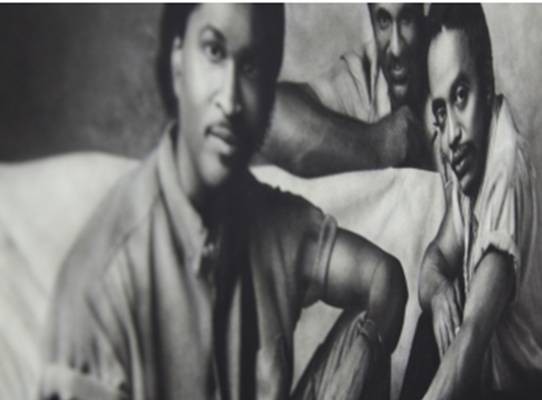Matthew Metzger
07 - 29 May 2011

© Matthew Metzger
43. In philosophy it is not enough to learn in every case what is to be said about a subject, but also how one must speak about it. We are always having to begin by learning the method of tackling it (distorted detail), 2011
Courtesy Tony Wight Gallery.
43. In philosophy it is not enough to learn in every case what is to be said about a subject, but also how one must speak about it. We are always having to begin by learning the method of tackling it (distorted detail), 2011
Courtesy Tony Wight Gallery.
UBS 12 × 12: New Artists/New Work:
MATTHEW METZGER
Nocturne
May 7-29, 2011
In Matthew Metzger's UBS 12 x 12 show Nocturne, two paintings—one depicting the cover of 1980s R&B group Surface's self-titled debut album, and the other a rubber band lying centered on a bare panel—frame a set of ten paintings, each representing one sheet of construction paper. These ten panels together represent the color spectrum in a pad of construction paper. All the exhibited paintings visually replicate the accurate dimension, color, and finish of the flat, two-dimensional sheets of paper along with every minute detail of the fibers, scratches, and surface marks. This blurs the difference between the painting and the original paper object, as both come together on the same plane. To do this, Metzger unites two opposing artistic traditions: 16th-century trompe l'oeil painting and 20th-century minimal and conceptual art, one tradition seeking to eliminate reality in favor of a heightened sense of illusion, the other to remove all illusion in favor of a heightened sense of reality.
Metzger's paintings suspend the difference between these two traditions. His aim is to examine the relationship between the form and color, while raising the elusive question: does color have a form? The result is a visual experience where what the viewer sees and what the viewer knows—the sensual and conceptual experience of the surface of objects—each paradoxically supporting and contradicting the other to raise the question: What is the form of color?
The result of this paradoxical situation is a chance to reflect on how our perception of surfaces and colors shape and form our understanding of objects.
Metzger (b. 1978) received his BFA from the University of North Texas and his MFA from the University of Chicago in 2009. He also attended the Skowhegan School of Sculpture and Painting.
MATTHEW METZGER
Nocturne
May 7-29, 2011
In Matthew Metzger's UBS 12 x 12 show Nocturne, two paintings—one depicting the cover of 1980s R&B group Surface's self-titled debut album, and the other a rubber band lying centered on a bare panel—frame a set of ten paintings, each representing one sheet of construction paper. These ten panels together represent the color spectrum in a pad of construction paper. All the exhibited paintings visually replicate the accurate dimension, color, and finish of the flat, two-dimensional sheets of paper along with every minute detail of the fibers, scratches, and surface marks. This blurs the difference between the painting and the original paper object, as both come together on the same plane. To do this, Metzger unites two opposing artistic traditions: 16th-century trompe l'oeil painting and 20th-century minimal and conceptual art, one tradition seeking to eliminate reality in favor of a heightened sense of illusion, the other to remove all illusion in favor of a heightened sense of reality.
Metzger's paintings suspend the difference between these two traditions. His aim is to examine the relationship between the form and color, while raising the elusive question: does color have a form? The result is a visual experience where what the viewer sees and what the viewer knows—the sensual and conceptual experience of the surface of objects—each paradoxically supporting and contradicting the other to raise the question: What is the form of color?
The result of this paradoxical situation is a chance to reflect on how our perception of surfaces and colors shape and form our understanding of objects.
Metzger (b. 1978) received his BFA from the University of North Texas and his MFA from the University of Chicago in 2009. He also attended the Skowhegan School of Sculpture and Painting.
